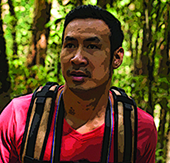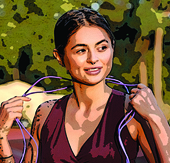

 |
 |
 |
 |
 |
  |
DAY 6 –Lajuma, the highest spot in the Soutpansberg mountain range
The group of hikers left Sigurwana Lodge with more than a bit of reluctance. They were preparing for the sixth day of their adventure, but the long hikes and steep ascent had taken a toll on their bodies. The day’s route would take them to the top of Lajuma, the highest spot in the Soutpansberg mountain range.
From the lodge they made their way towards a rocky cliff and a waterfall. The path took them down into a beautiful fever-tree forest at the base of the cliff. Edwin tried to cheer them up by encouraging them with quips and anecdotes. “As the saying goes, ‘What goes down must go up’, and we’ll soon be going up again. Just look at these lovely rocks,” he joked, “waiting for you to scale them in a jiffy…” They all groaned and muttered, but before long the hikers had no choice but to start climbing up the rocky slope again. They had to do a bit of scrambling in places to reach the ridge. Once at the top, the trail wound along the plateau with open grasslands and patches of forest.
“Look, there’s a klipspringer,” Taki remarked excitedly, pointing ahead. “Yes, or the Oreotragus oreotragus, if you want to sound like a nerdy researcher,” Zachary added. “They can jump between three and four metres in the air, which is remarkable for such a relatively small animal.” The rest of the hikers were too winded to share their enthusiasm.
The plateau and more open field allowed the hikers to spot more animals, but this also worked in favour of the animals, which quickly disappeared in the dense bushes. Edwin took them on a slight detour to visit two more rock-painting sites. By then, most of them were in slightly better condition, enough to enjoy the experience.
The walk to Lajuma was, fortunately for them, not very difficult, mostly continuing along vehicle tracks and single-track trails across the odd rocky outcrop. Mt Lajuma, which rises to 1 727 m above sea level, loomed ever closer, but before they started the ascent, the hikers first had to enter a small valley at its base.
Under a cluster of trees in the valley, Edwin called them to a halt and made the highly anticipated announcement: “It’s time for lunch.” The serene bushveld sounds were abruptly interrupted by the thumping noise of backpacks hitting the ground as the hikers wasted no time in settling down.
“Ahh! A spider!” Marelize suddenly yelled, jumping back. On her backpack, seemingly confused by the sudden intrusion, a highly irritated trapdoor spider of more than three centimetres gave her an eight-eyed glare.
“I’m guessing it’s an Entypesa schoutedeni Benoit, a species endemic to the mountain,” Zachary remarked dryly. “Don’t worry, it’s not venomous. I think thus far only one human death has been caused by one of them in the Soutpansberg region, and that is of a man who got a heart attack when one of the spiders landed on him … but of course, I’m joking,” he added when he saw the horrified looks on the faces of his fellow hikers.
“No, it’s no joke. If that thing lands on me, I will surely faint,” said Marelize, giving an involuntary shudder.
“You’re in spider country now,” Edwin mentioned casually as he joined the conversation. “A five-year survey was conducted at Lajuma a couple of years ago, and 46 families of spiders, represented by 130 species, were collected. This means that 70% of the spider species found in the country can be found on this farm,” he added, looking around hopefully. No luck!
To explain to the hikers how exceptional a habitat this was for spiders, Edwin tried to put things in context. “In the Kruger National Park, which stretches over 250 000 square kilometres, only 139 species have been recorded. A country such as Switzerland has only 39 spider families,” he added. Nobody looked remotely impressed, except Zachary, who nodded appreciatively.
“I still don’t like the way this one looks at me. He scares me,” said Marelize, still keeping a safe distance.
“See if you can spot a shield-bum trapdoor spider. To me they’re the most interesting, because they’re such weird-looking creatures,” Zachary remarked.
“Stop speaking about spiders, you’re freaking me out. Come on, Taki, it’s your turn to tell your story. Please, don’t let it be about a spider that bit you…” said Marelize.
Click here to view Taki's story
Day 6 - A bird’s eye view of some unique birds
“We’re heading for the top of the world … at least our little word here in the western Soutpansberg,” said Edwin while encouraging the group of hikers to get up and going again.
Edwin realised that they still had some climbing to do. The route between Sigurwana and Lajuma Wilderness was only about 15 kilometres, but the elevation gained was close to 550 metres. The lunch break in the shade of the trees had been a welcome break for everyone, but now they had to get going again.
The path took the group up a rocky slope to the saddle of Mt Lajuma. The climb required some athletic skills as it involved jumping from one rock to another, but gradually the chain of hikers found their way to a fence post, where they had to navigate around a small ledge carefully.
Marelize, who was not fond of heights, just fixed her gaze on Zachary’s rucksack in front of her, not daring to look down. Luckily, the scary part was only a few metres and, with some distance between her and the cliff, the colour in her cheeks returned.
The trail continued from the saddle, up rocky, grassy slopes, towards the top of Mt Lajuma. Here, at a height of 1 727m above sea level, the hikers were treated to the most amazing panoramic views. To the north, the Limpopo Valley was visible, with Botswana and Zimbabwe in the far distance. Towards the south, the bushveld plains were visible and they could see part of the route that they had travelled over the past couple of days. Towards the west, the mysterious Blouberg mountain could be seen, with its well-known vultures circling above.
“Blouberg is home to more than 500 pairs of the endangered Cape vulture. They have the most amazing vulture restaurant at the reserve,” said Edwin.
“Surely they don’t serve vultures at the restaurant. Who would eat vultures?” remarked Takalani, but by now the other hikers had grown accustomed to her weird sense of humour and ignored the question. The route was taking a lot of their attention anyway.
“The birds at Blouberg are quite amazing. If you’re lucky, you might see the Lappet-faced vulture, the hooded vulture, a white-headed vulture and the white-backed Vulture. Even the very rare Rüppell’s Vulture has been spotted breeding in the Blouberg Colony,” Zachary added, looking pleased to contribute his bit.
“I have read about the Rüppell’s Griffon Vulture,” said Lisa, who became quite interested in the discussion. “They come from East Africa, and the numbers are dwindling. I believe fewer than 22 000 of them are left. They can also fly at extreme high altitudes, with confirmed evidence of a flight at an altitude of 11 300 m above sea level. That makes it the world’s highest-flying bird,” she said, giving Zachary a quick, sly glance
For a few more minutes, the group of hikers stood looking at the horizon in amazement, hoping to catch more than a glimpse of the vultures. “Come on gents and ladies, we need to go down again,” Edwin spurred them on.
The trail backtracked down to the saddle, descending into ‘The Patches’, an open, grassy plain on Lajuma, with micro-forest patches. The descent was steep, slippery, and rocky and was hard on the legs. The hikers had to take care not to tumble down gracelessly. Once on the patches, the hiking became a bit easier, especially when they had reached the plain. From there, the route took them down a rocky path into the forest.
The group could sense that they were near Lajuma’s Wilderness Camp, once they had entered the forest. The sun was setting and the shadows became longer. After crossing a road leading east, they had only a few hundred metres more to go before they arrived at the camp.
The lodge was tucked away on a hillside, overlooking the river valley, with the waterfalls and pools right next to it. The lodge consisted of a main lapa with a fully equipped kitchen, an indoor fireplace and a spacious deck overlooking the valley and waterfalls. Two chalets with en-suite bathrooms and a double and single bed each invited them to come and rest.
After unpacking, the hikers flopped down on the chairs on the deck. This would be their last night in the Soutpansberg. Tomorrow they would head down, making their way to the historical town of Buysdorp, where their journey would end.
With the campfire burning with more intensity, the conversation picked up. “Tonight the deck is yours,” Adrian exclaimed dramatically, pointing at Rovha. “Tell us where you got those nasty scars on your leg.”
Meet the adventurers:
 |
Our narratorMarelize (27) is the narrator of the story. She is a seasoned traveller and has visited countries in Europe and the USA. |
|
Rovha is a soft-spoken dentist with smiling eyes. He is a loner and can often be found in a quiet corner reading a book or newspaper. |
 |
 |
Gerard is a Dutch adventure tourist. At 66 he has retired from the university he has been teaching at. He now spends his time travelling. |
|
Zachary (39) is a geologist. His insatiable thirst for adventure has taken him on many dangerous trails and earned him the title of Bear Grylls. |
 |
 |
Lee (28) has never let her neurological disorder become a disablity. Although physically strong, she has a emotional scar she hides well. |
|
Emma is a 37-year-old award-winning journalist who is currently working for a local newspaper but aspires to be a war photographer. |
 |
 |
Shabnim's small stature may be deceiving but at age 42, she is a tough adventurer and a well-respected lecturer at a local university. |
|
Adrian is a boisterous character who enjoys controlling the conversation. He usually leads the pack and shares his expertise freely. |
|
 |
With a military background, Gerrit (55) was a captain in the old South African Army. He has seen the horrors of war and still runs from it. |
|
For the vibrant and energetic 25-year-old Takalani (Taki) nursing has always been |
 |
 |
Lisa (53) is the mother of two grown daughters and the wife of a wealthy CEO who travels a lot. Lisa has taken up hiking to fill her days. |






